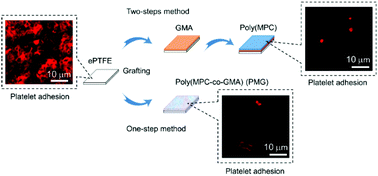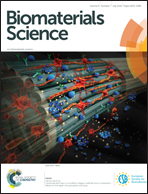A surface graft polymerization process on chemically stable medical ePTFE for suppressing platelet adhesion and activation†
Abstract
An effective surface grafting method for chemically inert and elaborately porous medical expanded-polytetrafluoroethylene (ePTFE) was developed. Although surface graft polymerization onto basic polymeric biomaterials has been widely studied, successful modification of the ePTFE surface has been lacking due to its high chemical resistance. Herein, we succeeded in surface graft polymerization onto ePTFE through glycidyl methacrylate (GMA) as a bridge linkage following argon (Ar) plasma treatment. The epoxy group of GMA was expected to react with the peroxide groups produced on ePTFE by Ar plasma exposure, and its methacrylic groups can copolymerize with various monomers. In the present study, we selected 2-methacryloyloxyethyl phosphorylcholine (MPC) as a model monomer and the blood compatibility of modified ePTFE was evaluated. Two sequences of surface grafting were compared. In a two-step graft polymerization, GMA was first immobilized onto Ar plasma treated ePTFE, and then MPC was polymerized. In a one-step graft copolymerization, MPC and GMA were mixed and copolymerized simultaneously onto Ar plasma treated ePTFE, resulting in a poly(MPC-co-GMA) (PMG) graft surface. The roughness of the node-and-fibril structure of ePTFE was reduced by the uniform polymer layer, and the modified ePTFE had a good hydrophilic nature even after being stored in an aqueous environment for 30 days. The indispensable GMA in graft polymerization improved the surface grafting on ePTFE. The one-step and two-step graft polymerization methods could decrease the number of adhered platelets, and almost inhibit platelet activation. We concluded that graft polymerization with the GMA linker provides a novel strategy to modify the chemically inert ePTFE surfaces for functionalizing as new medical devices.



 Please wait while we load your content...
Please wait while we load your content...